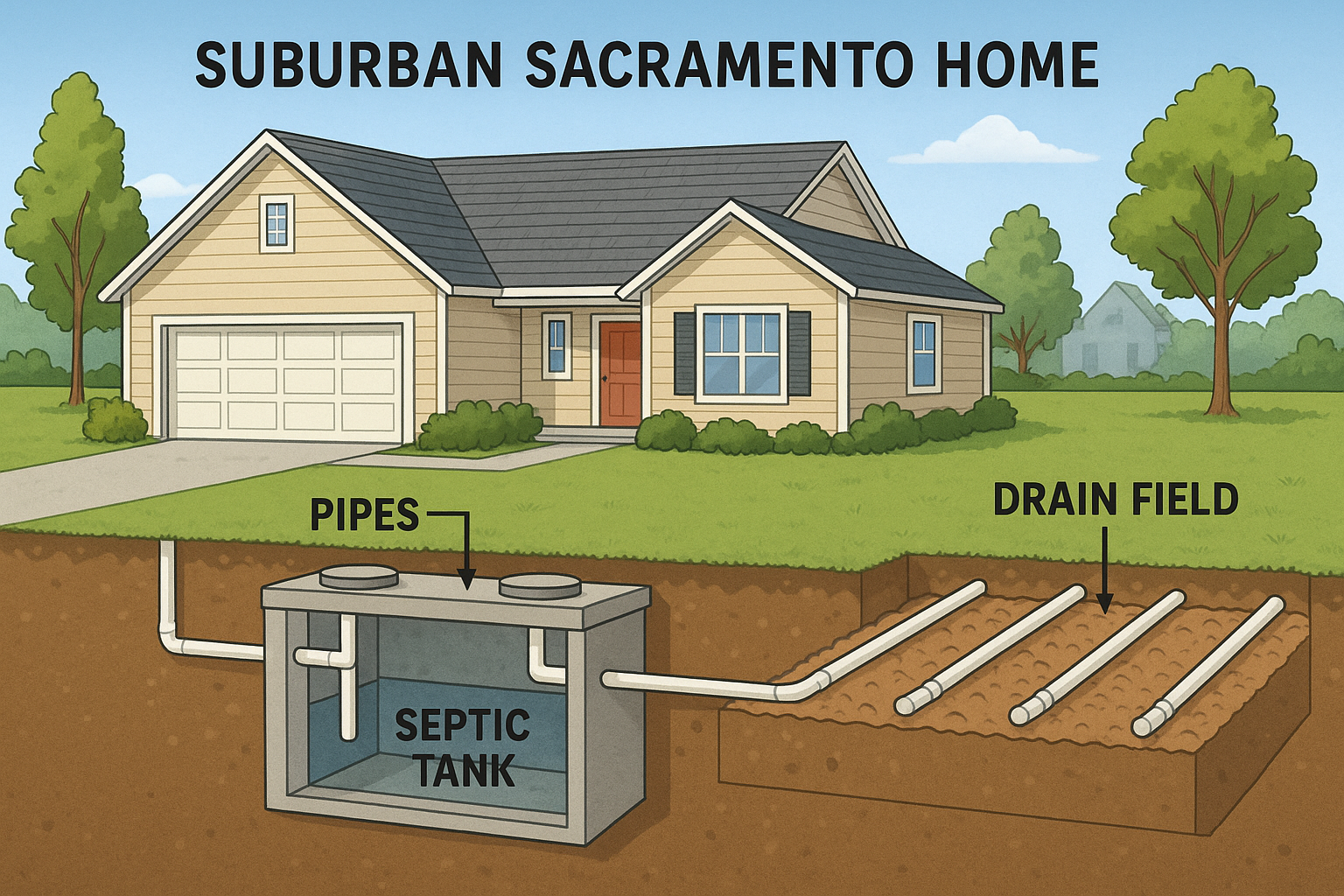Understanding Your Septic System Diagram as a Homeowner
Have you ever wondered what happens after you flush the toilet in a home without city sewer service? For Sacramento homeowners relying on septic systems, understanding your septic system diagram can make all the difference between smooth operation and expensive repairs.
A septic system isn’t mysterious: it’s a carefully engineered wastewater treatment process designed to operate underground. Yet, many homeowners don’t fully understand how each part connects, which makes maintaining it more difficult.
In this article, we’ll break down every section of your system, explain wastewater flow, and help you interpret both a septic tank system diagram and a diagram of a septic system like a professional. You’ll learn:
- What each part does and why it’s important
- How to identify potential problems early
- How to keep your system working efficiently for years
Let’s turn that confusing septic illustration into a useful homeowner resource.
What a Septic System Diagram Reveals About Your Home
A diagram of septic tank system layouts is more than just an image — it’s a visual blueprint showing how wastewater travels, is treated, and safely returns to the soil. Understanding your septic layout helps you locate parts, schedule maintenance, and prevent system overload.
Why It Matters
Your septic map provides more than just peace of mind: it’s your guide to preventing system failure. According to Forbes Home, having a clear diagram improves maintenance planning and helps avoid costly excavation work.
Here’s why it’s valuable:
- Helps locate underground components quickly
- Reduces confusion during inspections or emergencies
- Prevents accidental damage from home projects
- Guides service technicians for efficient repair and pumping
Common Misunderstanding
Many homeowners assume the septic tank “cleans” water completely. In reality, it pre-treats wastewater before it reaches the drain field, where soil bacteria finish the job. Understanding this process through a septic pump system diagram helps you manage maintenance properly.
How a Septic System Works Step-by-Step
A typical septic system drain field diagram highlights four primary components: the household plumbing, septic tank, distribution box, and drain field. Each plays a critical role in treating and filtering wastewater.
Household Plumbing and Waste Flow
All wastewater from sinks, showers, and toilets flows through your home’s main line into the septic tank.
Purpose: This section of your aeration septic system diagram shows how gravity drives wastewater from the house into the system.
Details:
- Pipes carry both solid and liquid waste
- Clogs here can appear as septic tank issues
- Regularly check for leaks or slow drains
Pro Tip: Avoid flushing wipes, grease, or non-biodegradable materials that can block pipes before reaching the tank. For routine care, check out septic tank cleaning and pumping.
The Septic Tank: Waste Breakdown and Separation
Every diagram of a septic system or septic tank system diagram shows the tank as the main treatment chamber. This watertight container (concrete or fiberglass) separates solids, scum, and effluent.
Purpose: The tank uses anaerobic bacteria to break down solids before sending partially treated liquid to the next stage.
Layers Inside:
- Scum layer: Oils and grease that float to the top
- Effluent layer: Clarified wastewater in the middle
- Sludge layer: Heavy solids settling at the bottom
Maintenance Tip: Pump your tank every 3–5 years to prevent overflow, especially in Sacramento’s clay-rich soils. For official inspections, visit real estate septic system inspections with full report.
The Distribution Box: Balancing the Flow
After the tank, wastewater enters the distribution box, which spreads liquid evenly into the drain field trenches.
Purpose: This crucial part of the diagram of septic tank system ensures even absorption across multiple leach lines.
Details:
- Prevents overloading one area
- Balances water distribution
- Requires proper leveling
Pro Tip: Have the D-box inspected yearly. Sediment buildup or root intrusion can cause backups. HomeAdvisor recommends annual inspections for older systems.
The Drain Field: Soil Filtration and Treatment
The septic system drain field diagram shows perforated pipes laid in gravel trenches across the yard. This final stage completes natural filtration.
Purpose: The soil acts as a biological and physical filter, removing pathogens, nutrients, and contaminants.
Details:
- Effluent percolates through gravel and soil layers
- Microbes in the soil treat wastewater naturally
- Avoid compacting or flooding the area
Pro Tip: Don’t drive or build over this field. Compaction reduces filtration and can cause failure. Learn more about tank locating and outlet baffle replacement.
Exploring Specialized Septic System Diagrams
Aerobic Septic System Diagram
An aerobic septic system diagram shows a modern setup where oxygen is pumped into the tank to promote aerobic bacterial activity.
Benefits:
- Breaks down waste faster than traditional systems
- Produces cleaner effluent for smaller lots
- Requires regular inspection of air pumps
The EPA notes that aerobic systems are ideal for environmentally sensitive areas and improve wastewater treatment efficiency.
Aerator Septic System Diagram
An aerator septic system diagram shows an electric aerator introducing air into the tank to support aerobic bacteria. Maintaining your aerator ensures consistent water quality and reduces odor.
Residential Aerobic Septic System Diagram
For Sacramento homes with limited yard space, a residential aerobic septic system diagram shows compact designs that treat wastewater efficiently through multiple aeration and disinfection stages. These are ideal for urban or small-lot properties.
Aeration Septic System Diagram
An aeration septic system diagram highlights how oxygen circulation enhances waste breakdown and reduces sludge buildup. Proper aeration minimizes maintenance and keeps systems odor-free. Learn about aeration equipment servicing with lift station pumping.
Septic Pump System Diagram
Some properties rely on pumps to move wastewater uphill or across distances. A septic pump system diagram includes the pump chamber, floats, and control box.
Pro Tip: Schedule annual checks to ensure float switches and alarms work correctly.
3 Float Septic System Wiring Diagram
A 3 float septic system wiring diagram displays the float switch configuration:
- Float 1: turns the pump off (low level)
- Float 2: turns the pump on (mid-level)
- Float 3: triggers a high-water alarm
Keep your wiring schematic near your control panel for troubleshooting. For safety, schedule professional inspection and septic riser and lid installation.
Practical Applications of a Septic System Diagram
1. Property Maintenance Planning
Homeowners use their septic tank system diagram to locate underground tanks and pipes before building patios, driveways, or pools—helping avoid costly excavation errors.
2. Professional Inspections and Repairs
Technicians at Blue Ribbon Septic use your diagram to locate components, lids, and flow lines efficiently. This reduces service time and repair costs.
3. Troubleshooting and Diagnostics
When slow drains or odors arise, reviewing your diagram of a septic system helps determine whether the issue lies in household plumbing, the tank, or the drain field. Angi recommends keeping a labeled copy of your layout for quick problem-solving.
Septic System Maintenance and Homeowner Tips
Even the most advanced systems need consistent care. Use your septic system diagram as a reference when maintaining or upgrading your home’s system.
- Pump Regularly: Every 3–5 years, depending on household size.
- Limit Water Usage: Spread out laundry loads to prevent flooding.
- Avoid Harsh Chemicals: They kill the bacteria your system depends on.
- Protect the Drain Field: Never drive or plant trees over it.
- Use Septic-Safe Products: Choose cleaners and toilet paper marked “septic safe.”
Pro Tip: Keep a printed copy of your septic tank system diagram in your home’s maintenance folder or near your electrical panel for quick access.
Mastering Your Septic System for Long-Term Reliability
Understanding your septic system diagram is more than identifying parts—it’s about protecting your home’s long-term health.
By visualizing how wastewater travels and how each section functions, you can maintain your system, prevent damage, and save thousands over time.
So, review your aeration septic system diagram, label each component, and reach out to Blue Ribbon Septic for expert maintenance, pumping, and repair services in Sacramento.
FAQs About Septic System Diagrams
1. What is a septic system diagram used for?
It shows all system components and how they connect, helping you and technicians locate tanks, pumps, and drain fields accurately.
2. How can I get a copy of my home’s septic system diagram?
Contact your local county health department or refer to original building permits in Sacramento.
3. How often should I inspect my septic tank?
Inspect every 1–3 years and pump every 3–5 years, depending on usage and household size.
4. Can I create my own septic system diagram?
Yes, homeowners can sketch their layout after locating lids and access ports. However, professionals provide precise diagrams for maintenance and resale.
5. What are signs my septic system may be failing?
Watch for slow drains, sewage odors, or wet areas above the drain field—these may indicate system failure.






